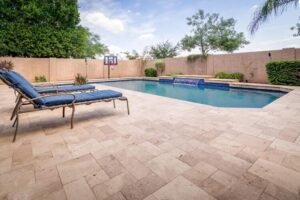If you think that your gorgeous interior design is enough to impress your guests or potential buyers of your property, then you must check this out. The exterior elements of your property, such as hardscape, walkway, driveway, sidewalk, garden paths, patio, patio paths, swimming pool, siding, exterior walls, and porch, are cumulatively responsible for creating that first impression. It is always known to us that first impressions play a great role in making up your mind to buy something, and travertine pavers play an important role here. If you are planning to sell your property at a higher price, then you should read through this.
Today, various materials are used for paving. But a natural stone is always a luxurious choice with its added advantages. More than this, recent advancements in quarrying technologies and shipping have made natural stones affordable selection. Of all the names in this long list of natural stones, travertine stones have made it to the top.
What is Travertine & how does it originate?
This is a sedimentary rock that falls into the category of limestone. However, the formation of travertine stone differs a lot from the common limestone rocks. It is found in the crust of the earth or submarine surfaces. Travertines chiefly contain precipitates of calcium carbonate compounds.
The precipitation of travertine takes place in areas of hot springs found in volcanic regions. These carry a lot of minerals from underground reservoirs. Travertine formation also takes place in the caves where groundwater leaching happens. During the formation of travertine rocks, a variety of minerals and other substances are also deposited. These become the cause of colours, textures, patterns, and style variations in the rocks. Travertine has a spongy nature, and porosity becomes obvious on the surfaces.
How are they available for use?
Natural rocks are mostly used in the form of stone veneers or tiles. These are sliced from the rock cubes. So, travertine stone veneers are available with different surface treatments. These are:
Tumbled Travertine Tiles
For those who prefer a rustic look, the tumbling process with rocks, sand, and water can enhance the natural feel of the travertine stone surfaces. We can get textured surfaces with holes/pores. This makes them non-slippery for exterior use.
Polished Travertine Tiles
It gives a smooth, glossy, and slippery finish. The smooth matte finish gives shining surfaces, which are easy to clean and highly resistant to stains.
Chiselled Travertine Tiles
It is not a surface treatment; rather it is an edge treatment only. The chiselled edge has a V-shaped indentation toward the back-side surface, and the front surface forms a ragged bevel.
Filled & Honed Travertine Tiles
In the process, pitted surfaces are filled with an epoxy resin material. Then, they are sanded down to get a natural texture with smooth surfaces.
What are some of the pros and cons of this material?
This material is similar to marble and granite. Travertine is considered a luxury material that will add style and a unique, beautiful element to the landscaping design. If we compare travertine to concrete pavers for pool deck perks, this material is pretty easy to handle and install. It is available in a range of sizes and cuts for custom installation. It can have a grain or pattern for a unique natural touch. However, a travertine tends to be uniform enough to cover a large area without clear mismatching.
Some of the advantages of travertine are listed here.
- It is quite durable and long-term.
- This has good porosity which allows for ideal drainage and quick drying around a pool area.
- It is resistant to damage from temperature variations.
- These have eco-friendly qualities.
- It is smooth and cool to walk on, even when hot.
- This has no efflorescence.
- Travertine will not host pests or attract insects.
- It is resistant to freeze-thaw cycles.
While there are many perks of using travertine, this material comes with a few cons to consider. These are:
- Travertine must be sealed initially and re-sealed over time.
- Some liquids can cause etching or staining.
- Weight can pose an issue unless the deck is properly stabilised.
- It is available in limited colours beyond natural tones.
- This can chip or crack with hard use.
Conclusion
Thus, travertine pavers are a better and trendy choice for your aesthetic pavings. Besides the list of advantages, there are a few drawbacks to these natural pavers. But what fits you right depends on your preferences.
For more information, visit Apzo Media





